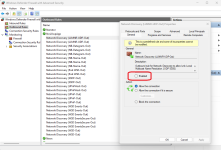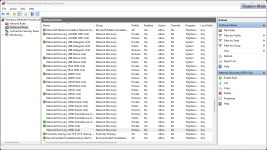netsh advfirewall set allprofiles state on
rem Block all inbound network traffic and all outbound except allowed apps
netsh advfirewall set DomainProfile firewallpolicy blockinboundalways,blockoutbound
netsh advfirewall set PrivateProfile firewallpolicy blockinboundalways,blockoutbound
netsh advfirewall set PublicProfile firewallpolicy blockinboundalways,allowoutbound
rem Remove All Windows Firewall Rules
netsh advfirewall firewall delete rule name=all
rem Windows Firewall Block Rules
netsh advfirewall firewall add rule name="TCP Block" dir=out action=block protocol=TCP remoteport=1-42,44-79,81-442,444-586,588-852,854-992,994-1024,1025-3073,3075-5227,5229-27014,27051-65535
netsh advfirewall firewall add rule name="UDP Block" dir=out action=block protocol=UDP remoteport=1-122,124-442,444-1024
netsh advfirewall firewall add rule name="Brave TCP" dir=out action=block protocol=TCP remoteport=1-442,444-5227,5229-65535 program="%LocalAppData%\BraveSoftware\Brave-Browser\Application\brave.exe"
netsh advfirewall firewall add rule name="Brave UDP" dir=out action=block protocol=UDP remoteport=1-442,444-65535 program="%LocalAppData%\BraveSoftware\Brave-Browser\Application\brave.exe"
netsh advfirewall firewall add rule name="Edge TCP" dir=out action=block protocol=TCP remoteport=1-442,444-65535 program="%ProgramFiles(x86)%\Microsoft\Edge\Application\msedge.exe"
netsh advfirewall firewall add rule name="Edge UDP" dir=out action=block protocol=UDP program="%ProgramFiles(x86)%\Microsoft\Edge\Application\msedge.exe"
netsh advfirewall firewall add rule name="LibreWolf TCP" dir=out action=block protocol=TCP remoteport=1-442,444-65535 program="%ProgramFiles%\LibreWolf\librewolf.exe"
netsh advfirewall firewall add rule name="LibreWolf UDP" dir=out action=block protocol=UDP program="%ProgramFiles%\LibreWolf\librewolf.exe"
netsh advfirewall firewall add rule name="OneDrive TCP" dir=out action=block protocol=TCP remoteport=1-442,444-65535 program="%ProgramFiles%\Microsoft OneDrive\OneDrive.exe"
netsh advfirewall firewall add rule name="IceDrive TCP" dir=out action=block protocol=TCP remoteport=1-442,444-65535 program="%LocalAppData%\Temp\IcedrivePortable\Icedrive.exe"



